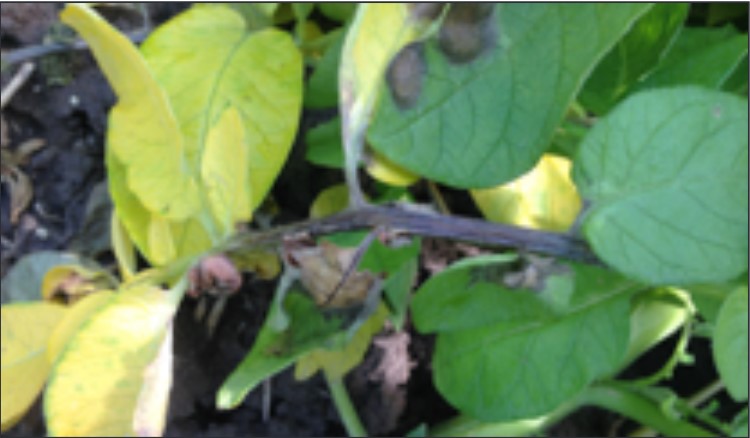
Late Blight in Garden Potatoes
Late blight of potato is a disease of great concern wherever potatoes are grown. The organism responsible for late blight, Phytopthora infestans, is known as the “plant destroyer.” All parts of the potato plant are susceptible to late blight. The disease often appears following periods of very wet weather.
Last Updated: 12/16by Jessica Rupp, Extension Plant Pathologist; and Nina Zidack, Director, Montana State University Potato Lab
The seed potato industry in Montana
Seed potatoes are an important crop in Montana and are a crucial quality seed source for potato production across the United States. The cooperation of home gardeners to control diseases of great concern, such as late blight, is essential for the individual, the community, the state, and the entire country.
Montana is one of the top five seed-potato producing states. According to the Montana Department of Agriculture, the state's seed potatoes are prized because growing areas are somewhat isolated from airborne spores of diseases such as late blight. To protect this industry, Montana only allows potatoes that originate in Montana to be grown as certified seed, and requires all seed potatoes to be inspected at shipping point. Businesses can sell garden seed potatoes from outside Montana, but need to be inspected at the point of shipping and have an accompanying health certificate.
Foliar Symptoms
On very young leaves, irregular, water-soaked lesions appear. Lesions are dark brown to black, and can appear small at first. A light green halo often appears around the lesion. Left untreated, lesions enlarge into circular necrotic patches.
Tuber symptoms
Tuber infection is characterized by brown to purplish, slightly depressed regions on the skin. Upon peeling back tuber epidermis (skin), reddish-brown to dark brown, granular tissue is apparent. This rusty-colored granular rot usually extends less than half an inch into the tuber. Infection often appears to be quite dry unless invaded by secondary soft-rotting organisms.
Disease Cycle
Overwintering and reproduction of the pathogen P. infestans requires a living host. Without a sexual reproduction cycle, P. infestans is an obligate parasite (a parasitic organism that cannot complete its life-cycle without exploiting a suitable host). Therefore, survival between seasons is dependent on infected tubers. Sporangia (a cell or structure in which spores are produced) are dispersed aerially from infected material present in storage, cull piles, and soil. Spores germinate within hours in the presence of free moisture. Lesions can result in secondary sporulation in as little as four days. The pathogen prefers moderate temperatures from 60-80 ?F with leaf wetness 10 hours a day. Tubers can become infected at any time from planting through harvest. Sporangia can be washed downward into the soil from the surface.
Management
Late blight is one of the most studied diseases of any crop, therefore intensive integrated management programs exist. The first and most important step is to use disease-free seed potatoes. No varieties have resistance to all late blight strains, but some have resistance to individual strains. Good soil drainage and proper plant spacing for optimal air movement are desirable. Proper sanitation is necessary. Destroy suspect potatoes, do not compost. Deep hilling (bringing loose soil up around the vines and lower leaves where the potatoes will form) can be used to protect tubers from sporangia washing off leaves. Time irrigation so that leaves dry during the day. Avoid excessive fertilization to prevent canopy overgrowth. Preventative treatments are most effective against late blight. Choose products with active ingredients chlorothalonil, mancozeb. Organic growers may use copper. Thorough coverage of the plant is required, and repeated applications are recommended. Follow label guidelines for rate and frequency. Be vigilant when conditions are cool and moist and because some late blight strains infect tomatoes, be sure to purchase only healthy tomato transplant
Fungicides
Fungicide application is considered an integral part of late blight management. Contact fungicides have proven particularly useful by coating the leaves to prevent pathogen development. Use at labeled dose and at recommended intervals. Systemic fungicides can be used with varied levels of success following infection. Fungicide chosen after infection is detected must be strain dependent. Some strains have resistance to metalaxyl/mefanoxam. In situations where the strain remains unknown, use an alternate fungicide. Infected vines can be destroyed by a dessicant or burning.
Action Points
- Use disease-free certified seed.
- Use fungicide seed treatments.
- Prepare an action plan ahead of time.
- Scout gardens for signs of the disease regularly.
- Maintain awareness of disease presence in the state.
- Apply irrigation according to guidelines.
- If Late Blight is suspected, contact MSU Extension at 406-994-5572 or the Montana Seed Potato Certification Program at 406-994-3150.
Storage recommendations
- Harvest during dry weather
- Provide adequate airflow during storage

FIGURE 1. Early infection appears as a short pencil mark that rapidly expands into a grey-black lesion. One characteristic of late blight is dark lesions with a very light green halo. The green halo is the pathogen hyphae growing in living cells.

FIGURE 2. Dark brown to black lesions on leaves and stems.

FIGURE 3. Potato tuber with late blight symptoms present.

